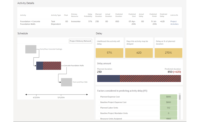

Seeking to capitalize on the rise of cloud-based computing, Autodesk is offering a subscription-based software service as a complement to its extensive suite of design tools.
The 2013 editions of Autodesk's Building Design Suite, Infrastructure Design Suite and Plant Design Suite, for example, would include basic access to the company's cloud-based Autodesk 360 service. The Autodesk 360 service includes parts of the Horizontal Glue collaboration software the firm acquired with its November 2011 purchase of Horizontal Systems.
Horizontal Glue is one of the more popular online platforms for sharing BIM documents in a web environment, including clash detection, estimates scheduling and RFIs.
Autodesk CEO Carl Bass considers "rendering in the cloud" to be the next trend in cloud computing. "We're able now to take analysis that previously was able to be done only on workstation-class devices.Some of these calculations could take anywhere from hours to days to compute [with traditional systems]," said Bass at a media event in San Francisco on March 27. "We're now able to do it in the cloud in an hour, in 15 minutes."
Andrew Anagnost, Autodesk senior vice president for industry strategy and marketing, sees the release as a starting point for offering the company's flagship software, such as Revit and Navisworks, entirely online. "In three years we expect every single Autodesk product will have some cloud [service]," he says.
Each Autodesk 360 account will come with 3 GB of online storage and the ability to view and share design files. A paid subscription grants access to more storage as well as some cloud-based rendering, structural analysis and energy analysis, Autodesk says.
"Right now, [Autodesk 360] is primarily a visualization tool," says Anagnost. "But, over time, you will see us layering into that environment more and more computationally intensive functions, using the cloud to do more than the desktop."





Post a comment to this article
Report Abusive Comment